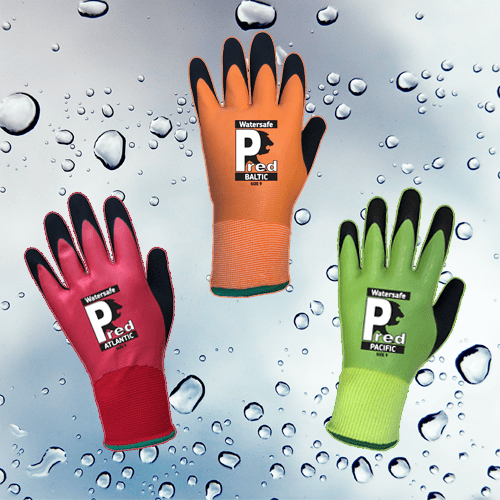EN388 – Protection against mechanical hazards
The standard EN388:2016 is designed for gloves which are used to protect against mechanical hazards, representing a glove’s performance when used for various different tasks. This standard is mandatory for CAT II gloves and all parts of the test are completed on a section of the palm area.
The standard is broken down into 6 test areas (seen to the right). Each test undertaken will result in a performance level… abrasion, tear, and puncture range from 1 to 4 (4 being the highest); coupe cut test ranges from 1 to 5 (5 being the highest); ISO19337 ranges from A to F (F being the highest); and, the Impact test, if passed, is indicated with the letter (P).
Gloves which have undergone EN388 tests will bear the hammer shield to the right on either the outer of the product or on the label inside. Not all parts of the test must be completed – only those relevant to the product – however, any areas not tested should bear an X in place of a number (with exception of the Impact test).
Abrasion Resistance
In this test, sandpaper discs are placed onto the sample and rotated until break-through is achieved on the sample material. The number of rotations/cycles dictates the performance level of the glove.
The result measurements for this test, by level, are set out below:
- 100 cycles
- 500 cycles
- 2,000 cycles
- 8,000 cycles
Cut Resistance (Coupe)
In this cut test, a rotating blade with a fixed weight of 5N is run back and forth across the test sample until the blade cuts through. The test is calculating the number of cycles the blade can run before making contact with the base of the machine. Here, 5 samples are tested and an average is calculated, which donates the final performance level. The test is stopped once 60 cycles has been reached and no cut-through has been achieved. At that point, it is mandatory that you switch to the ISO19337 cut test method.
As the same blade is used for all samples, blunting can occur which can provide conflicting or inaccurate results – hence the ISO19337 test was developed. Similarly, this test is not always suitable for gloves which contain metal as this can trigger a false-end to the test, as when the blade on the machine makes contact with the metal base, it believes the test has been completed.
The result measurements for this test, by level, are set out below:
- 1.2 cycles
- 2.5 cycles
- 5 cycles
- 10 cycles
- 20 cycles
Tear Resistance
This test measures the force required (in Newtons) to tear the sample material.
The result measurements for this test, by level, are set out below:
- 10 Newtons
- 25 Newtons
- 50 Newtons
- 75 Newtons
Puncture Resistance
In this test, a steel stylus (similar to a large nail) is lowered onto the test sample (which is stretched tight) with increasing force. The performance level is calculated by the force (in Newtons) required to puncture through the glove.
The result measurements for this test, by level, are set out below:
- 20 Newtons
- 60 Newtons
- 100 Newtons
- 150 Newtons
Cut Resistance (ISO13997)
Suitable for higher cut level gloves or gloves which surpass the 60 cycles in the Coupe methodology, this test assesses the strength required to cut through the sample, with letters used to indicate the performance level instead of digits.
In this test, a straight blade is used for each cut-stroke and variable weight load applied. The test calculates the force required (in Newtons) to cut through the material whilst the blade travels a 20mm distance.
The result measurements for this test, by level, are set out below:
- A: 2 – 4.9 Newtons
- B: 5 – 9.9 Newtons
- C: 10 – 14.9 Newtons
- D: 15 – 21.9 Newtons
- E: 22 – 29.9 Newtons
- F: 30 Newtons or more
For more information on ISO13997, click here to read our dedicated blog.
Impact Resistance
The Impact test is carried out in accordance with the requirements and test methods in clause 6.9 of EN 13594:2015 – ‘Protective gloves for motorcycle riders’.
Here, the gloves are cut open and flattened before being placed over a domed anvil. This sample is then impacted with a 2.5kg flat-headed hammer from a sufficient height to result in impact energy of 5J. The test is performed on 4 different samples and the peak force is detected by a sensor in the anvil.
To pass, the mean force must be ≤7.0kN and the no single result can be equal to or exceed 9.0kN… other requirements in this test the glove not tearing or breaking, or any parts shattering into sharp and potentially dangerous elements.
This test results in either a straight pass or fail – if the glove has passed, a P will stand in place of the performance level… if the glove fails, no result will be advertised.
If you are interested more information on the above standard or any of our products, you can contact us via the below:
Call – 01653 617718
Email – sales@just1source.com





